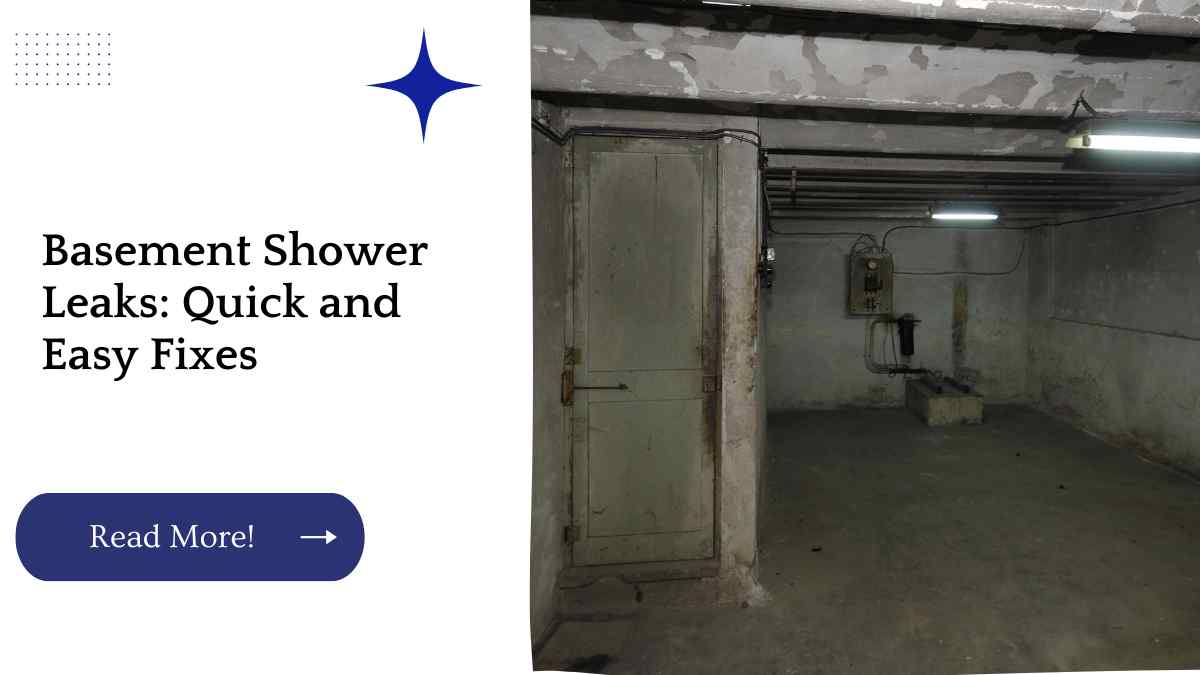Are you experiencing leaks from your basement shower? A leaking shower can be a major problem that could lead to water damage and mold growth.
Fortunately, there are several quick and easy fixes that you can do to stop the leak and prevent any further damage. In this article, we will discuss various ways to fix basement shower leaks.
| Key Takeaways |
|---|
| Identifying the cause of the leak is crucial for proper repair. |
| A leaking showerhead or faucet can be fixed by replacing worn-out parts or using plumber’s tape. |
| If the shower pan or drain is damaged, it needs to be replaced or repaired. |
| Sealing the shower walls and floor can prevent future leaks. |
| Replacing the shower stall may be necessary if the damage is extensive. |
| Proper maintenance and regular inspections can prevent future leaks and water damage. |
Identify the Cause of the Leak
Before you can fix the leak, you need to identify the source of the problem. There are several possible causes of basement shower leaks, including:
- Damaged showerhead or faucet
- Cracked or damaged shower pan or drain
- Poorly sealed shower walls or floor
- Improperly installed or outdated shower stall
Check the Showerhead and Faucet
If the leak is coming from the showerhead or faucet, it may be due to worn-out parts or loose connections. Here’s how to fix it:
- Turn off the water supply to the shower.
- Remove the showerhead or faucet using a wrench.
- Inspect the parts for wear and tear or damage.
- Replace any damaged parts, such as washers or gaskets.
- Reattach the showerhead or faucet and turn on the water supply.
- If the leak persists, wrap plumber’s tape around the connections to create a tight seal.
Basement leaks are not only frustrating, but they can also cause significant damage. That’s why it’s important to perform routine sewer pipe maintenance to prevent these leaks from happening in the first place.
Inspect the Shower Pan and Drain
If the leak is coming from the shower pan or drain, it may be due to cracks or damage. Here’s how to fix it:
- Remove the shower drain cover using a screwdriver.
- Inspect the shower pan and drain for cracks or damage.
- If there are cracks, use epoxy or silicone caulk to seal them.
- If the drain is damaged, replace it with a new one.
- Reattach the shower drain cover.
Fix the Shower Pan and Drain
If the shower pan or drain is beyond repair, you may need to replace them. Here’s how to do it:
- Remove the shower stall and any tiles or flooring around the shower area.
- Remove the old shower pan and drain using a saw or pry bar.
- Install a new shower pan and drain, making sure they fit properly.
- Reinstall the shower stall and any tiles or flooring.
Seal the Shower Walls and Floor
If the leak is due to poorly sealed shower walls or floor, you can fix it with caulking or grout. Here
- Seal the Shower Walls and Floor (cont.)
- Remove any old caulk or grout using a scraper or grout removal tool.
- Clean the area thoroughly with a mildew remover and let it dry completely.
- Apply caulk or grout along the edges of the shower walls and floor, making sure to fill any gaps or cracks.
- Smooth the caulk or grout with a caulk smoothing tool or your finger.
- Let the caulk or grout dry completely before using the shower.
A basement shower that won’t drain properly can be a nuisance, but did you know that it can also be a sign of a larger plumbing issue? Check out this article on washing machine draining into your sink for a similar solution to this common problem
Replace the Shower Stall
If the damage to the shower stall is extensive, you may need to replace it completely. Here’s how to do it:
- Remove any tiles or flooring around the shower area.
- Remove the old shower stall using a saw or pry bar.
- Install a new shower stall, making sure it fits properly.
- Reinstall any tiles or flooring around the shower area.
Prevent Future Leaks
Preventing future leaks is essential to avoid any water damage or mold growth. Here are some tips to help prevent basement shower leaks:
- Regularly inspect the shower area for any signs of leaks or damage.
- Replace worn-out parts, such as washers and gaskets, as soon as possible.
- Use plumber’s tape to create a tight seal around connections.
- Use a mildew remover to clean the shower area regularly.
- Seal any gaps or cracks in the shower walls or floor using caulk or grout.
Rusty screws on your bathtub overflow cover can be an unsightly and annoying problem. Fortunately, there are quick and easy fixes that you can do yourself to remedy the situation and restore the appearance of your bathtub.
Clean Up and Restoration
If your basement shower has leaked, you may need to clean up and restore the affected area. Here’s how to do it:
- Remove any standing water with a wet/dry vacuum or towels.
- Use a mildew remover to clean the affected area thoroughly.
- Let the area dry completely.
- Repair any damage to the walls, floor, or ceiling.
- Apply paint or sealant to the affected area.
Common Mistakes to Avoid
When fixing basement shower leaks, there are some common mistakes you should avoid:
- Ignoring signs of leaks or damage
- Using the wrong tools or materials
- Failing to turn off the water supply before starting repairs
- Rushing the repair process
- Forgetting to seal the shower walls or floor after repairs
Proper drainage is essential to prevent water damage, especially in your basement. That’s why it’s important to find the right drainage pipe for your driveway to ensure that water flows away from your home without causing any harm.
Frequently Asked Questions (FAQs)
Q1. Can I fix a leaking showerhead or faucet myself?
Yes, you can fix a leaking showerhead or faucet yourself by replacing worn-out parts or using plumber’s tape to create a tight seal.
Q2. How do I know if my shower pan or drain is damaged?
You can inspect the shower pan and drain for cracks or damage. If you find any, you can seal them using epoxy or silicone caulk or replace them if they are beyond repair.
Q3. How often should I inspect my basement shower for leaks?
You should inspect your basement shower for leaks regularly, ideally once a month.
Q4. Can a leaking basement shower cause mold growth?
Yes, a leaking basement shower can cause mold growth, which can be hazardous to your health.
Q5. Do I need to hire a professional to fix my basement shower leaks?
It depends on the extent of the damage and your DIY skills. If the damage is extensive, it’s best to hire a professional to ensure proper repairs.
Dealing with a stuck drain snake can be frustrating, but there are ways to tackle the problem. Check out our guide on how to remove a stuck drain snake with ease for some helpful tips on fixing this plumbing issue.
Further Reading
Here are some additional resources that you may find helpful in fixing basement shower leaks:
Have Shower Leaks Behind Wall? Fix Them in 6 Simple Steps: This blog post provides step-by-step instructions for fixing shower leaks that are behind the wall.
Shower Drain Leaking into Basement? Here’s How to Fix It!: This article offers tips for fixing a shower drain that is leaking into the basement.
How to Fix a Leaking Shower: This wikiHow article provides a detailed guide on how to fix a leaking shower, including common causes of leaks and step-by-step instructions for repairs.
Conclusion
Basement shower leaks can be a major problem that could lead to water damage and mold growth. However, with the right tools and knowledge, you can easily fix the problem and prevent any further damage. Remember to identify the source of the leak, use the right tools and materials, and seal the shower walls and floor properly to prevent future leaks.

Hellen James is the author of the blog and a licensed plumber with over 15 years of experience. She shares her knowledge and experience in plumbing and drainage through insightful and informative articles

